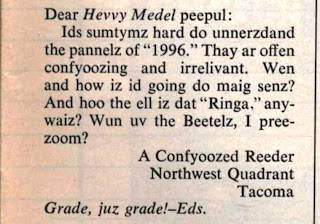Book Review: 'Glory Season' by David Brin
4 / 5 Stars
‘Glory Season’ was first published in 1993 in hardback; this Bantam Spectra paperback was issued in 1994. The cover illustration is by Gary Ruddell.
The planet Stratos is not your usual, run-of-the-mill colonized world. Settled thousands of years ago by a rogue technocrat named Lysos, who elected to shun any contact with the Federation, Stratos is designed to represent the ultimate Gyn/Ecology: a society governed by collections of matriarchies, each comprised of female clones generated via parthenogenesis.
Serving as a sort of lumpen proletariat to the clones are the ‘vars’, women birthed from regular sexual reproduction. As the progeny of sweaty couplings, the vars are destined for subservience, and have few aspirations beyond founding their own modest matriarchies, modeled on those exhibited by their cloned superiors.
On Stratos, men are relegated to a minor role in terms of population, occupation, and status; at select times of the year they contribute to the conception of the vars, but thereafter are consigned to stay separated from their offspring, and women, for most of their lives.
Maia and her sister Leie are teenaged vars, and as the novel opens they are leaving their childhood home for mandatory exile and career-seeking amid the merchant fleets of the Eastern Continent. Despite their lack of nautical experience, the sisters procure positions on the tramp steamer Wotan. They embark on series of adventures set among the coasts and inland regions of the Eastern continent.
As they go about their exploration of Stratos, the twins become more aware of a note of uncertainty in their world’s politics: after centuries of isolation, a Federation scout ship has arrived in orbit around Stratos, and its passenger is rumored to have landed on the planet to parley with the ruling oligarchies.
The reintroduction of possible contact with the Federation is a double-edged sword; many factions on Stratos want nothing to do with the Federation and its distressing aura of Patriarchy.
For these clone factions, the social order must be preserved at all costs; the uninvited visitor must be prevented from introducing change and disruption to Stratoin society.
For these clone factions, the social order must be preserved at all costs; the uninvited visitor must be prevented from introducing change and disruption to Stratoin society.
But for many var factions, the chance for access to new technologies, technologies promising to overturn the strictures of Stratos society, technologies promising hitherto unthinkable advancement for the underclass, is a chance that must not go unexploited.
Maia soon finds herself befriending the envoy from the Federation, a circumstance that makes her an unwilling participant in the bitter, and increasingly violent, conflicts between factions. For the envoy knows things about Stratos and the planet’s history, information that the ruling class is adamant about keeping hidden from both men and vars….
At 773 pages in length, ‘Glory’ is a brick of a book. Somewhat inevitably in a book of this length, author Brin tends to devote a bit too much text to the internal musings and conflicts of Maia, his main character.
As well, an overly large amount of the narrative is preoccupied with Game Theory and evolutionary modeling. Later in the novel fractals, another hot topic in the early 90s science scene, gets a belabored treatment.
As well, an overly large amount of the narrative is preoccupied with Game Theory and evolutionary modeling. Later in the novel fractals, another hot topic in the early 90s science scene, gets a belabored treatment.
But (somewhat surprisingly) the book is quite readable, no mean feat for so lengthy a narrative, and I didn’t have too much trouble going through hefty chunks of it in one sitting.
Brin wisely avoids plastering his novel with too much exposition on gender theory and the rivalries between Men and Womyn, a weakness I've observed in books with similar themes written by female authors.
Brin wisely avoids plastering his novel with too much exposition on gender theory and the rivalries between Men and Womyn, a weakness I've observed in books with similar themes written by female authors.
[Gor fanboys should note, this is not their type of novel.]









































































